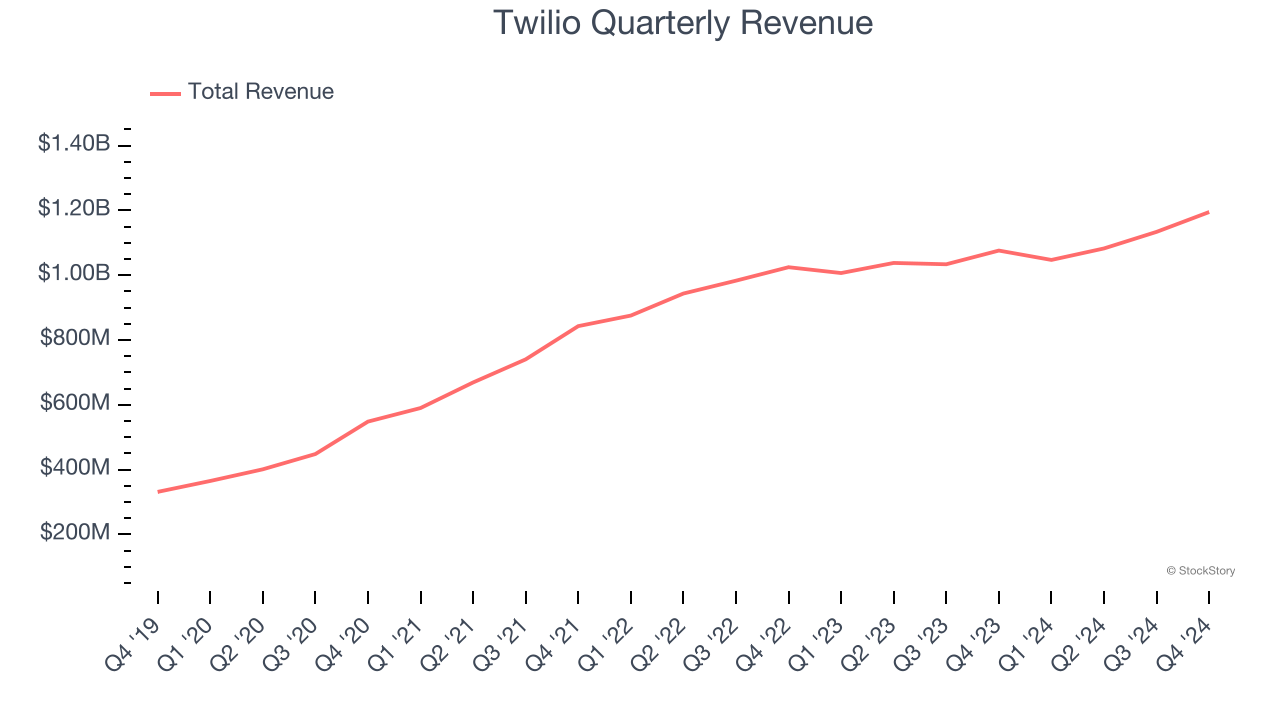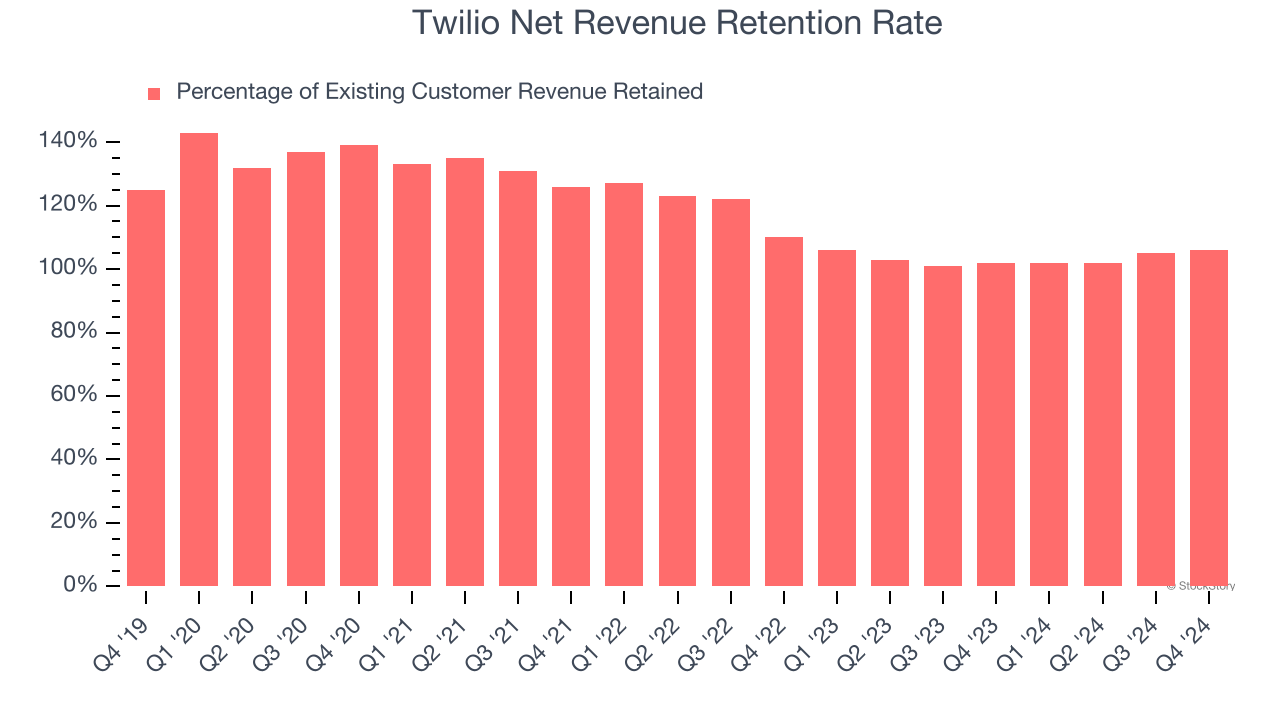
Cloud communications infrastructure company Twilio (NYSE: TWLO) reported revenue ahead of Wall Street’s expectations in Q4 CY2024, with sales up 11% year on year to $1.19 billion. The company expects next quarter’s revenue to be around $1.14 billion, close to analysts’ estimates. Its non-GAAP profit of $1 per share was 3.2% below analysts’ consensus estimates.
Is now the time to buy Twilio? Find out by accessing our full research report, it’s free.
Twilio (TWLO) Q4 CY2024 Highlights:
- Revenue: $1.19 billion vs analyst estimates of $1.18 billion (11% year-on-year growth, 1.5% beat)
- Adjusted EPS: $1 vs analyst expectations of $1.03 (3.2% miss)
- Adjusted Operating Income: $197 million vs analyst estimates of $197.8 million (16.5% margin, in line)
- Revenue Guidance for Q1 CY2025 is $1.14 billion at the midpoint, roughly in line with what analysts were expecting
- Adjusted EPS guidance for Q1 CY2025 is $0.91 at the midpoint, below analyst estimates of $0.98
- Operating Margin: 1.1%, up from -33.6% in the same quarter last year
- Free Cash Flow Margin: 7.8%, down from 16.7% in the previous quarter
- Customers: 325,000, up from 320,000 in the previous quarter
- Net Revenue Retention Rate: 106%, up from 105% in the previous quarter
- Market Capitalization: $22.18 billion
Company Overview
Founded in 2008 by Jeff Lawson, a former engineer at Amazon, Twilio (NYSE: TWLO) is a software as a service platform that makes it really easy for software developers to use text messaging, voice calls and other forms of communication in their apps.
Communications Platform
The first shift towards voice communication over the internet (VOIP), rather than traditional phone networks, happened when the enterprises started replacing business phones with the cheaper VOIP technology. Today, the rise of the consumer internet has increased the need for two way audio and video functionality in applications, driving demand for software tools and platforms that enable this utility.
Sales Growth
A company’s long-term performance is an indicator of its overall quality. While any business can experience short-term success, top-performing ones enjoy sustained growth for years. Over the last three years, Twilio grew its sales at a 16.2% compounded annual growth rate. Although this growth is acceptable on an absolute basis, it fell slightly short of our benchmark for the software sector, which enjoys a number of secular tailwinds.

This quarter, Twilio reported year-on-year revenue growth of 11%, and its $1.19 billion of revenue exceeded Wall Street’s estimates by 1.5%. Company management is currently guiding for a 8.4% year-on-year increase in sales next quarter.
Looking further ahead, sell-side analysts expect revenue to grow 7.7% over the next 12 months, a deceleration versus the last three years. This projection is underwhelming and implies its products and services will see some demand headwinds.
Unless you’ve been living under a rock, it should be obvious by now that generative AI is going to have a huge impact on how large corporations do business. While Nvidia and AMD are trading close to all-time highs, we prefer a lesser-known (but still profitable) stock benefiting from the rise of AI. Click here to access our free report one of our favorites growth stories.
Customer Retention
One of the best parts about the software-as-a-service business model (and a reason why they trade at high valuation multiples) is that customers typically spend more on a company’s products and services over time.
Twilio’s net revenue retention rate, a key performance metric measuring how much money existing customers from a year ago are spending today, was 104% in Q4. This means Twilio would’ve grown its revenue by 3.8% even if it didn’t win any new customers over the last 12 months.

Trending up over the last year, Twilio has an adequate net retention rate, showing us that it generally keeps customers but lags behind the best SaaS businesses, which routinely post net retention rates of 120%+.
Key Takeaways from Twilio’s Q4 Results
It was great to see Twilio grow its customers this quarter. We were also happy its revenue outperformed Wall Street’s estimates. On the other hand, its EPS guidance for next quarter missed significantly and its revenue guidance for next quarter was in line with Wall Street’s estimates. Overall, this was a weaker quarter. The stock traded down 5.3% to $139.50 immediately following the results.
Twilio’s latest earnings report disappointed. One quarter doesn’t define a company’s quality, so let’s explore whether the stock is a buy at the current price. The latest quarter does matter, but not nearly as much as longer-term fundamentals and valuation, when deciding if the stock is a buy. We cover that in our actionable full research report which you can read here, it’s free.






